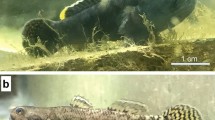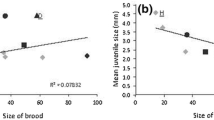Abstract
Adult females of a halocyprid ostracod, Conchoecia pseudodiscophora, collected from the mesopelagic zone of the Japan Sea in June and September 1990, were fed frozen and freshly killed copepods and maintained in the laboratory to assess brood size, number of broods, the interval between consecutive broods and egg hatchability. A single female released 1 to 10 eggs brood-1 (mean: 5.9 eggs, N=35), and the intervals between consecutive broods ranged widely, from 2 to 64 d (mean: 31.0d, N=16). As many as four consecutive broods were recorded for two females. Mean hatchability of eggs was 72.7% (N=25), with no apparent relation with the number of consecutive broods and season. Hatching time of eggs was 12 to 15d at 0.5°C. Newly hatched juveniles (Instar I) developed to Instar II in 32d, and to Instar III in 72d, at 0.5°C. Judging from the morphology of appendages. Instars I and II were non-feeding stages. Morphological and dimensional data for eggs and Instars I, II and III obtained in this laboratory experiment were compared with those from field samples. The total number of instars and growth of C. pseudodiscophora are discussed in conjunction with presently available data on halocyprid ostracods.
Similar content being viewed by others
Literature cited
Angel, M. V. (1972). Planktonic oceanic ostracods—historical, present and future. Proc. R. Soc. Edinb. (Sect. B) 23: 213–228
Angel, M. V. (1979). Studies on Atlantic halocyprid ostracods: their vertical distributions and community structure in the central gyre region along latitude 30°N from off Africa to Bermuda. Prog. Oceanogr. 8: 3–124
Angel, M. V. (1983). A review of the progress of research on halocyprid and other oceanic planktonic ostracods 1972–1982. In: Maddocks, R. F. (ed). Applications of Ostracoda. Univ. Houston Geosciences, Houston, p. 529–548
Childress, J. J., Price, M. H. (1983). Growth rate of the bathypelagic crustacean Gnathophausia ingens (Mysidacea: Lophogastridae). II. Accumulation of material and energy. Mar. Biol. 76: 165–177
Cohen, A. C. (1982). Ostracoda. In: Parket, S. P. (ed.) Synopsis and classification of living organisms. 2. McGraw-Hill, New York, p. 181–202
Cohen, A. C., Morin, J. G. (1990). Patterns of reproduction in ostracods: a review. J. Crustacean Biol. (Lawrence, Kansas) 10: 184–211
Deevey, G. B. (1968). Pelagic ostracods of the Sargasso Sea off Bermuda: description of species and seasonal and vertical distribution. Bull. Peabody Mus. nat. Hist. 26: 1–125
Hartnoll, R. G. (1985). Growth, sexual maturity and reproductive output. In: Wenner, A. M. (ed.) Factors in adult growth. Crustacean Issues 3. A. A. Balkema, Rotterdam, p. 101–128
Hillman, N. S. (1969). Ontogenic studies of antarctic pelagic Ostracoda, Antarctic J. U. S. 4: 189–190
Hiruta, S. (1984). Preliminary report on life history of marine Ostracoda. Bull. Japan Ass. Benthology 26: 31–37 (in Japanese with English abstract)
Ikeda, T. (1984). Development of the larvae of the Antarctic krill (Euphausia superba Dana) observed in the laboratory. J. exp. mar. Biol. Ecol. 75: 107–117
Ikeda, T. (1986). Preliminary observations on the development of the larvae of Euphausia crystallorophias Holt and Tattersall in the laboratory. Mem. natn. Inst. polar Res., Tokyo (Spec. Issue) 40: 183–186
Ikeda, T. (1990). Ecological and biological features of a mesopelagic ostracod, Conchoecia pseudodiscophora, in the Japan Sea. Mar. Biol. 107: 453–461
Kesling, R. V. (1953). A slide rule for the determination of instars in ostracod species. Contr. Mus. Palcont. Univ. Mich. 11: 97–109
McLaren, I. A., Corkett, C. J., Zillioux, E. J. (1969). Temperature adaptations of copepod eggs from the arctic to the tropics. Biol. Bull. mar. biol. Lab., Woods Hole 137: 486–493
Müller, G. W. (1906). Ostracoda. Wiss. Ergebn. dt. Deutschen Tiefsee-Expedition. ‘Valdivia’ 8: 1–154
Omori, M., Ikeda, T. (1984). Methods in marine zooplankton ecology. John Wiley & Sons, New York
Poulsen, E. M. (1973). Ostracoda — Myodocopa. Part IIIB. Halocyprifomes — Halocypridae Conchoecinae. Dana Rep. 84: 1–224
Tseng, W. Y. (1975). Biology of the pelagic ostracod Euconchoecia elongata Müller. Taiwan Fish. Res. Inst. Lab. Fish. Biol. Rep. 27: 1–183
Tseng, W. Y. (1976). Development of the pelagic ostracod, Euconchoecia elongata Müller, 1906. Abh. Verh. naturw. Ver. Hamburg 18/19 (Suppl.): 201–213
Vinogradov, M. E. (1968). Vertical distribution of the oceanic zooplankton. Israel Program for Scientific Translations, Jerusalem
Author information
Authors and Affiliations
Additional information
Communicated by M. Anraku, Suva
Rights and permissions
About this article
Cite this article
Ikeda, T. Laboratory observations on spawning, fecundity and early development of a mesopelagic ostracod, Conchoecia pseudodiscophora, from the Japan Sea. Mar. Biol. 112, 313–318 (1992). https://doi.org/10.1007/BF00702477
Accepted:
Published:
Issue Date:
DOI: https://doi.org/10.1007/BF00702477




